Poetry & Poets
Explore the beauty of poetry – discover the poet within

How To Structure A Poetry Comparison Essay

Introduction
Comparing two poems typically involves analyzing the content and structure of the poetry, as well as its universal themes, language, and the imagery used. Writing a poetry comparison essay is considered a formidable task for many because determining the similarities and differences between two pieces of poetry can be quite difficult. With the right approach, however, it’s quite possible to produce an impressive essay. For example, It’s essential to understand that it doesn’t suffice to point out the differences and similarities between two pieces of poetry, explain how they compare and contrast, and then summarize the findings. To write a successful paper, one needs to apply higher-level thinking to structure information gathered from researching the poems. This article provides useful tips on how to compare two poems and structure a successful poetry comparison essay.
Finding two poems to compare
The first step to writing a successful poetry comparison essay is finding two poems to compare. To facilitate this process, one can choose two poems by the same author or two poems on the same subject or theme. Alternatively, one can compare or contrast poems from different authors with content that explores the same themes, such as love, war, etc. Alternatively, one can go through existing literary criticism material or search in literary databases to find poets/poems to compare.
Creating a thesis statement
Next, it’s essential to put together a persuasive thesis statement that explains how two poems are related in terms of a specific literary element or idea. A thesis statement should make a direct, clear, and concise point. It’s also important to back up points made with direct citations or reference to the poems. Depending on the topic of the essay, the thesis statement may contain a number of concepts discussed in the body of the essay.
Outlining the paper
The structure of the paper should include an introduction with a thesis statement, a body, and a conclusion. A great example of an outline for this type of paper would be as follows: 1. Introduction with a thesis statement 2. Explain the first poem 3. Explain the second poem 4. Discussion of the differences and similarities between the two poems 5. Conclusion Moreover, it’s important to clearly point out how the comparison of the two poems relates back to the thesis statement. If the paper is more than 5 paragraphs, one may consider adding a paragraph discussing how each poem imparts a certain meaning or provides insight into a larger idea, such as how two poets view a single subject differently.
Discussing structure

When discussing the structure of two poems, one must look at how both poems are organized. This includes paying attention to the titles of the poems, the length of the lines, and the use of words. Perhaps, one poem has a traditional structure and rhythm, while the other is more flexible in terms of structure. Maybe the two poems have a similar tone or mood, yet have different ideas about a particular topic. How the poems use language to provide perspective or build an idea is also essential to consider.
Analyzing content
For this section, it’s important to focus on comparing the content and ideas of both poems. This includes looking at the themes, imagery, and characters in the poems, as well as the symbols, metaphors, and figurative language used by the characters. Likewise, one can analyze the type of diction and syntax that is used to create a certain tone or mood. Moreover, it’s important to consider how the message or meaning of a poem changes when it is viewed as part of a larger context. For example, is the author expressing a particular point of view, or is the poem a response to a previous poem?
Comparing universal themes
The final element to consider when writing a poetry comparison essay is the universal themes that are evident in each poem. Universal themes are the underlying messages that give shape to the poem and can be found in most poems. Examples of universal themes include love, loss, mortality, loneliness, joy, and growth. It’s important to examine how the poets explore these universal themes in each poem and consider how the themes work together to create a unique perspective. Additionally, one can consider how a poem might be interpreted differently by different readers due to their personal experiences.
In conclusion, writing a successful poetry comparison essay requires an in-depth analysis of two poems and the development of an overall argument or point of view. It’s essential to pick two poems to compare, create a thesis statement, develop an organized outline, and analyze the structure, content, and universal themes of both poems. With the right attention to detail and strategy, it is possible to write a successful, impactful, and well-structured poetry comparison essay.
Discussing structure of each poem

When evaluating the structure of both poems, one should focus on the title, length of lines, and the words used. For instance, one poem may have a traditional structure and rhythm, while the other might have a looser structure with irregular recurring patterns. On top of that, the two poems may or may not have the same tone or mood. It may be worth noting the difference in how the authors use words to help build their ideas.
Activity: Describing Content of each poem
When it comes to the content of both poems, consider to analyse the themes, characters, and symbols in each work. For example, what type of metaphors are used? What kind of diction and syntax help to create the mood and tone? Also, try to look at how the idea of each poem works within a larger context. For instance, is the poem a response to another poem or is it a stand-alone work?
Examining universal themes
The core messages in both pieces of poetry are known as the universal themes. These themes could be something like love, loss, or mortality. Look for these themes and analyse how each author explores those universal themes. Additionally, consider how the poem might be interpreted differently based upon different reader’s individual experiences.
Structuring the paper
When it comes to putting the paper together, you will need to create an outline. A great outline would be something like: Introduction, explanation of each poem, comparison of differences and similarities, and conclusion. Remind yourself of the thesis statement and make sure the comparison of both poems relates back to it. If the paper is more than 5 paragraphs, consider adding a section discussing how each poem imparts a certain meaning or provides insight into a larger idea.

Minnie Walters
Minnie Walters is a passionate writer and lover of poetry. She has a deep knowledge and appreciation for the work of famous poets such as William Wordsworth, Emily Dickinson, Robert Frost, and many more. She hopes you will also fall in love with poetry!
Leave a Comment Cancel reply
- Primary Hub
- Art & Design
- Design & Technology
- Health & Wellbeing
- Secondary Hub
- Citizenship
- Primary CPD
- Secondary CPD
- Book Awards
- All Products
- Primary Products
- Secondary Products
- School Trips
- Trip Directory
- Trips by Subject
- Trips by Type
- Trips by Region
- Submit a Trip Venue
Trending stories

Top results

- How To Write The Perfect Comparative Essay On Poetry
Poetry comparison – How to write the perfect comparative essay

When it comes to poetry analysis, Phil Beadle knows what examiners want to see – and he’s here to make sure you can help every student can deliver it

Poetry comparison – or writing a comparative essay about two poems, seen or unseen – is what students will eventually be assessed on when they come to sit the poetry analysis part of their English Literature GCSE .
It makes sense, therefore, to get some early poetry comparison practice in. See what the assessment criteria will be asking for in preparation for the day the stakes are high.
The first door we must knock on is the one housing the crone of context. What the GCSE mark schemes will eventually ask for is a well constructed, conceptual response replete with oodles of subject terminology and a fairly deep mention of context.
It asks students to do this, however, in very little time. It also ignores the fact that contextual analysis in poetry – aside from the obvious modern/ancient dichotomy – is a rich brew that requires, firstly, a lot of contextual knowledge.
Also ignored is the fact that the biographical takes you away from the textual. Since the value in poetry analysis is the study of how words and form align to construct beauty or its antithesis, mention of context inevitably takes you into the realms of history. This is a whole other subject.
Poetry comparison example
Resources: ‘My Last Duchess’, by Robert Browning ‘Remains’, by Simon Armitage
Context – theme
So, my recommendation to students when constructing the first paragraph of a poetry comparison essay is, if appropriate, to make glancing reference to the titles. Only go so far as linking these to comparison of theme. The contextual is in the thematic.
On comparing theme, they should make explicit reference to the word ‘subtextual’. This flags to the examiner that this is an answer rich in apposite use of subject terminology quite early on. For example:
“The subtextual theme of ‘My Last Duchess’ is that sexual jealousy can cause the empowered (in this case titled) men – or, indeed, just men – to so lose their minds. They become murderous. Whereas the subtextual theme of ‘Remains’ links to the ambiguities of the title.
“As a noun, it links to the idea of the human remains of the looter around which the narrative revolves. As a verb, all that is left is memory.
“Both these poems linger around ideas of memory. Both narrators are tortured. But whereas the narrator in ‘Remains’ realises that he is stained by his actions, the narrator of ‘My Last Duchess’ is oblivious and has learned altogether nothing.”
Structure – rhyme
This is as far as we might want to go with context. Otherwise, we are addressing the poetic with its opposite and scribing a list of dates.
So, the next paragraph should examine structure. We do so by using rhyme scheme and form as a way of unlocking it. First of all, say what you see and, where possible, state the form:
“‘My Last Duchess’ is from Browning’s collection of ‘Dramatic Monologues’. It’s a substantial block of text with one person, the Duke, speaking. ‘Remains’ is seven quatrain stanzas and a couplet.”
Analysis of rhyme scheme
This is simple to do and gives students an opportunity to shovel a bit of subject terminology the examiners’ way. Generally, it is best to leave this unanalysed however. This is because analysis of rhyme scheme is much richer in terms of unlocking structure.
“The rhyme scheme in ‘My Last Duchess’ is in perfect couplets. On the other hand, ‘Remains’ is the epitome of deliberate irregularity.
“If one is to take this as a symbolic suggestion of the degree of order in both dramatic and moral worlds, one might conclude that the world of the former poem is ordered and correct, whereas that of the latter is chaotic and incongruent.
“There is an irony in the Duke speaking in perfect rhyme, being able to rhyme “munificence” and “pretence” and then suggesting he has no “Skill in speech”. This suggests him to be the liar he is.
“But the more interesting approach is in ‘Remains’: three out of four of the end words in stanza one, in which the looters raid the bank, are repeated in stanza six, when the incident is replayed in the narrator’s memory.
“The fact that only three of the four words -“out”, “bank”, “not” – are repeated suggests the decay of memory. Internal rhyme also plays a part in the pivot between action turning into memory. The fourth stanza features eye rhymes ”agony”, “by”, “body” before going into near perfect rhyme that carries on into the next stanza, “lorry”, “really”.
“But “really” is an add on, a coda to the phrase “End of story”. It suggests that the death of the looter should have been the finish of the event, but that there is an unpleasant coda. This is the fact that memory ‘remains’.”
You can get a lot from a poem through examining the rhyme in detail.
Metre – stress
From there, we go onto a fairly stunted form of metrical analysis; and we do this precisely because others avoid it.
I am not suggesting that students attempt analysis of trochees and anapests. After all, to our modern untrained ears, the differences between stressed and unstressed syllables can be unfathomable.
But where there is obvious metric change, we take this as a signal from the poet to pay special attention to this line (and to analyse it).
“ Metrically, ‘My Last Duchess’ appears to be in tetrameter with the odd substitution, “I call”. This, again, might be taken to suggest the narrator’s level of control over his circumstances.
“ The metre in ‘Remains’ is used to create specific effects. It is broadly irregular except in stanzas one, three and six (even, event, recall) where it goes into tetrameter.
“ The substitutions on “Sleep” and “Dream”, however, give a jarring effect, an elongated stutter, a metric pause. This sets up the brief moment of peace before the nightmare of replayed events comes back to haunt him.”
Language – reflections
We do not go over the top with metrical analysis. Just one comparison is enough to let the examiner know we are on top of the brief.
“We do not go over the top with metrical analysis”
From there, we divert into the linguistic. Show the examiner that you can recognise the idea that the soundtrack of the poem is somehow a representation or mirror of the poem’s themes. One killer comparison is all we need:
“Ultimately, the distinction is between a narrator rich in self delusion and one haunted by self knowledge. Both are murderers, but one has no guilt over an action he considered before committing. The other took a rapid action that now haunts him.
“The difference in consideration is signalled by the punctuation. There is a difference between the time implied by the commas in “probably armed, possibly not” and the semi colons in “This grew; I gave commands; then all smiles stopped together”.
“It tells us much about their comparative level of ruthlessness and design at the moment of decision. There is also a distinction in maturity that is signalled by the howling childishness of the ‘oo’ sounds in “forsooth”, “choose” and “stoop” and the deadening emotional stutter of pain in the repetitive ‘n’ sounds in the penultimate line of ‘Remains’.”
And as for conclusions for your comparisons in poetry essay, don’t bother. We haven’t got the time, and they are always rubbish anyway.
Phil Beadle is a teacher and the author of several books. This includes Rules for Mavericks: A Manifesto for dissident creatives (Crown House). Check out our AQA English Literature Paper 1 revision resource .
Sign up to our newsletter
You'll also receive regular updates from Teachwire with free lesson plans, great new teaching ideas, offers and more. (You can unsubscribe at any time.)
Which sectors are you interested in?
Early Years
Thank you for signing up to our emails!
You might also be interested in...

Why join Teachwire?
Get what you need to become a better teacher with unlimited access to exclusive free classroom resources and expert CPD downloads.
Exclusive classroom resource downloads
Free worksheets and lesson plans
CPD downloads, written by experts
Resource packs to supercharge your planning
Special web-only magazine editions
Educational podcasts & resources
Access to free literacy webinars
Newsletters and offers
Create free account
By signing up you agree to our terms and conditions and privacy policy .
Already have an account? Log in here
Thanks, you're almost there
To help us show you teaching resources, downloads and more you’ll love, complete your profile below.
Welcome to Teachwire!
Set up your account.
Lorem ipsum dolor sit amet consectetur adipisicing elit. Commodi nulla quos inventore beatae tenetur.
I would like to receive regular updates from Teachwire with free lesson plans, great new teaching ideas, offers and more. (You can unsubscribe at any time.)
Log in to Teachwire
Not registered with Teachwire? Sign up for free
Reset Password
Remembered your password? Login here


The Hyperbolit School
Your trusty englit guide.
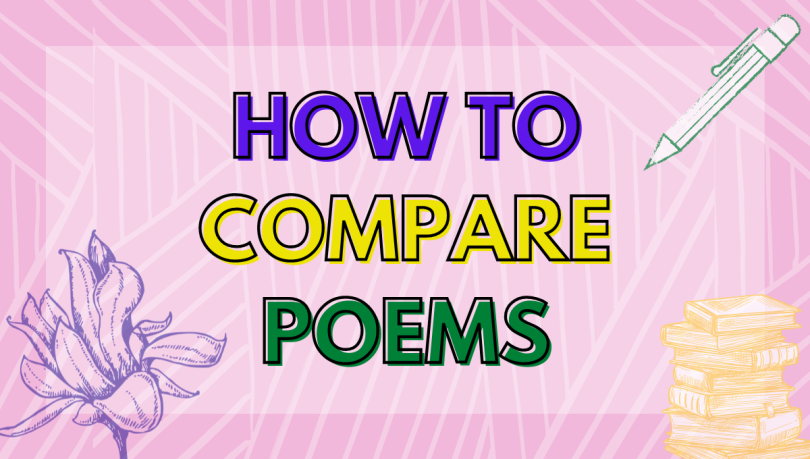
How to compare poems – 5 steps
Previously, I wrote a post on how to analyse any unseen poem , which a lot of you found useful. One of you asked if I could also write a guide on how to compare poems, so that’s what this post is for.
What’s the deal with comparative analysis – and why does it always seem so much harder…?
Between an unseen single-poem analysis task and a prepared comparative poetry analysis task, which one would you prefer?
Both can be tricky to master, but neither is unmanageable – we just need to find the right strategy.
Personally, I think the reason that comparative tasks seem more challenging is largely psychological. It’s not so much that the act of comparing texts itself is hard as it is that we get easily flustered when asked to multitask – especially in a high-stress situation like an exam.
Obviously, if these are set texts that you can prepare for, that should relieve a lot of the stress which would otherwise come with tackling an unseen comparative task (with the right sort of guidance, granted).
So, what’s my point here?
I’m trying to say if you find comparative tasks intimidating, don’t – because
a) there’s a systematic way to go about doing it well, and
b) I’m going to show you just how to do it in this post, complete with steps and examples.
5 steps to comparing any poems: a guide
Step 1: summarise the main idea of each poem in 1-2 sentences , step 2: find similarities – thematic, stylistic, structural and formal, step 3: find differences from similarities , step 4: identify 3 key ideas for comparison, step 5: summarise your main argument in a comparative statement.
Or watch my video below, in which I go through the 5 steps to comparing poems (but stick around this blog post for a demonstration of how to do it in the next section, where I compare Carol Rumens and Seamus Heaney’s poems):
What’s the first thing we do when encountering any poem? We read it, of course. But what do you do after you first read the poem? We’re likely to re-read it – either because we don’t really ‘get it’ the first time round, or because we need to start sourcing clues for our analysis.
Re-reading is all good and well (not to mention necessary), but the problem with it is there’s potentially no end to how many times we could re-read a poem, and so the more we re-read, the more we’re likely to be led into a labyrinthe of questions, which causes more confusion. In normal, non-exam circumstances, that’s perfectly fine, but if you’re racing against time, then a better tactic is to read once, then summarise your first impressions; read twice, and summarise the main idea of the poem.
But, what if I really don’t get it? Obviously, there’s room to take ‘once’ or ‘twice’ liberally, so no issues if you have to re-read a couple of times before you can summarise anything. My point, however, is not to get sucked into an endless process of reading and re-reading, because before long you’ll have whittled all your time away – only to have nothing to show for it at the end.
To prevent this, start actively engaging with the poem by asking yourself these questions immediately after reading it:
What is the main gist of the poem’s content?
How do I feel after reading this poem?
What are some themes or ideas that jump out at me?
Is there anything special or weird about this poem?
Etcetera.
Then, scribble them down on your planning sheet (you should always plan before you write!), so at least you’re visualizing your response to the poem, which gives you a much better place to start than simply keeping everything in an abstract, befuddled jumble in your head. These notes don’t have to be long – just 1-2 sentences or even bullet points will suffice.

Once we’ve settled on a main understanding of the poems, it’s time to switch our thinking to a ‘lateral’ mode. By ‘lateral’, I mean to think across both poems in terms of different aspects of analysis (i.e. theme, style, structure, form), instead of focusing on only one poem at a time.
Let’s start by looking at the similarities in theme, style, structure and form between the poems. If you’ve read my post on ‘how to tackle any unseen poetry’ (which you should!), you’ll know I love me some tables, rows and columns, so here’s a sample table for us to systematise our observations:
Similarities between Poem A and Poem B
Again, as I’ve mentioned in the unseen post, the ability to spot these similarities (and differences, as we’ll cover in the next step) is predicated on us being familiar with the technical basics. I.e., we can’t spot a metaphor if we don’t know what metaphor means, so make sure that you sort out the fundamentals first – a wobbly foundation is no place to start any poetry analysis task, comparative, unseen, or otherwise.

Differences across poems can appear on multiple levels. There can be complete differences (e.g. Poem A is a sonnet whereas Poem B is a ballad), but more often, we’re looking for ‘differences within similarities’. This is why a good place to start identifying differences is, perhaps a bit ironically, in our similarities table.
The guiding questions to ask, then, would include the following:
How do the poems present the same theme in different ways?
How do the poets use the same stylistic, structural or formal techniques to present different aspects of the theme?
For instance, while both poems may be about love, A could be about unrequited love and B about mutual love, so there’s a thematic difference for you. Alternatively, both poems may feature comparative devices, but while metaphors are used to compare love with dandelions in Poem A, similes could be used to compare love with an onion in Poem B.
Likewise, both poems may be odes , but perhaps A is a Pindaric ode, while B is a Horatian ode (for a more detailed explanation of the ode, read this post). So on so forth. You’ll notice that the ‘differences’, then, could simply be your analysis of the different quotations you’ve sourced for each poem’s ‘similarities’.
So instead of creating a new table, we can add one extra line underneath each aspect of analysis to address how each ‘similarity’ differs across the poems, like this:
Once we’ve reviewed all the ‘differences-in-similarities’, we can then zoom out and see if there are other fundamental points of divergence between the poems, i.e. is there something in Poem A that’s totally absent from Poem B, and vice versa? If it serves your argument to also bring these points in, then feel free to add them in.
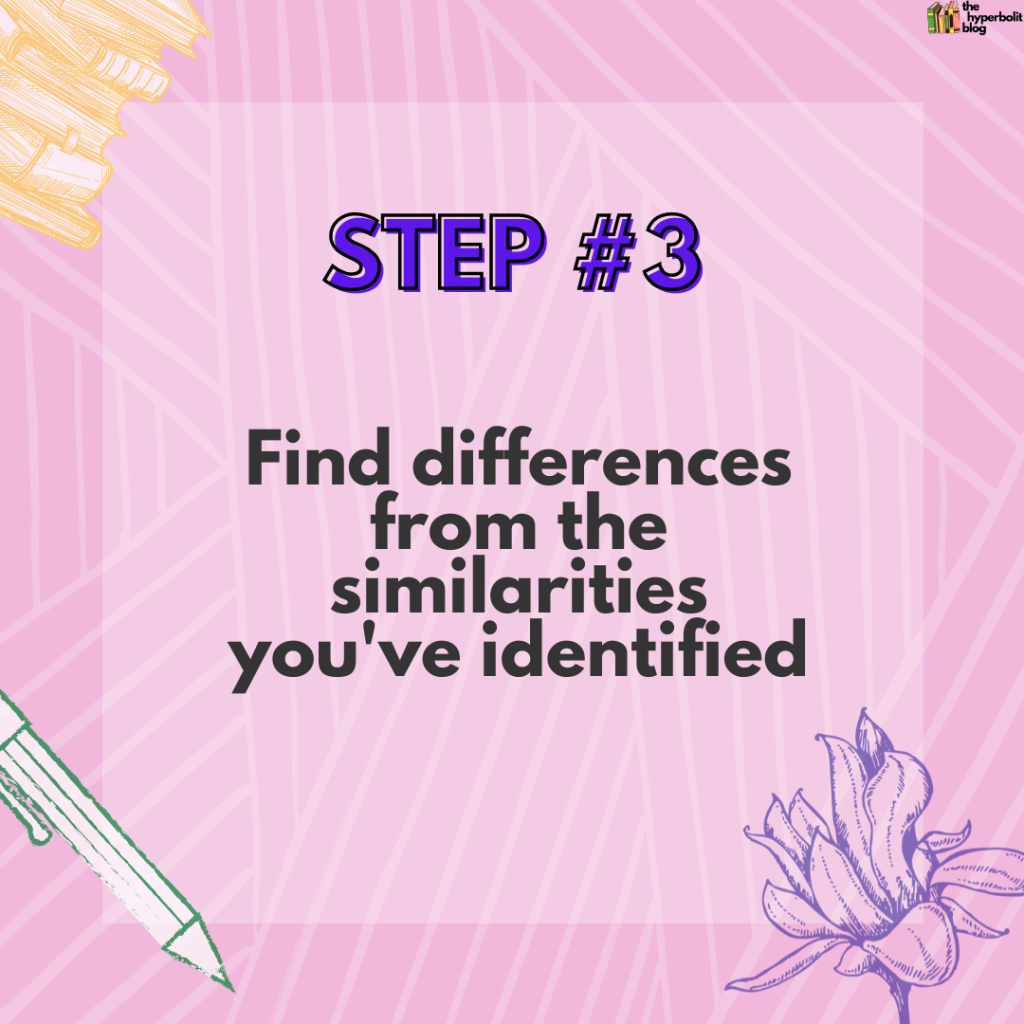
Now that we’ve mapped out all the thematic, stylistic, structural and formal similarities and differences, it’s time to zoom in on how the theme is presented from various angles through the use of style, structure and form.
This means going back to the quotations we’ve sourced for the stylistic, structural and formal categories in each table, and looking at how these quotations present the theme in different ways through the poet’s use of techniques.
The purpose of this is to identify 3 main points of discussion for our main body section, which could look something like this:
Main body 1: How the poems present the nature of love (unrequited vs mutual)
- Techniques used for this: Poem A (metaphor); Poem B (rhyme)
Main body 2: How the poems present the fickleness of love, regardless of unrequited or mutual affections
- Techniques used for this: Poem A (organic imagery); Poem B (irony)
Main body 3: How the poems reach their respective revelation about the role of love in our lives
- Techniques used for this: Poem A (indentation / formal variation); Poem B (rhyming couplet at the end)
Together, your 3 main body points should cover the entirety of both texts, and not be limited to just one section of each poem. As for the ‘techniques used’, these should come in organically as part of your analysis, as you explain how the poet(s) convey these ideas through the use of metaphor , rhyme, organic imagery , irony etc.
One more point to note is this: even within a comparative framework, there’s likely to be an arc of transformation in the way a theme is portrayed in each poem.
So, if Poem A is about unrequited love, does it begin in a despairing tone, but ends on a more stoic note? And if Poem B is about mutual love, is the idea presented in a purely joyful light throughout the poem, or does an element of doubt seep in halfway?
It’s important that we pay attention to these changes within each poem even while comparing across poems.
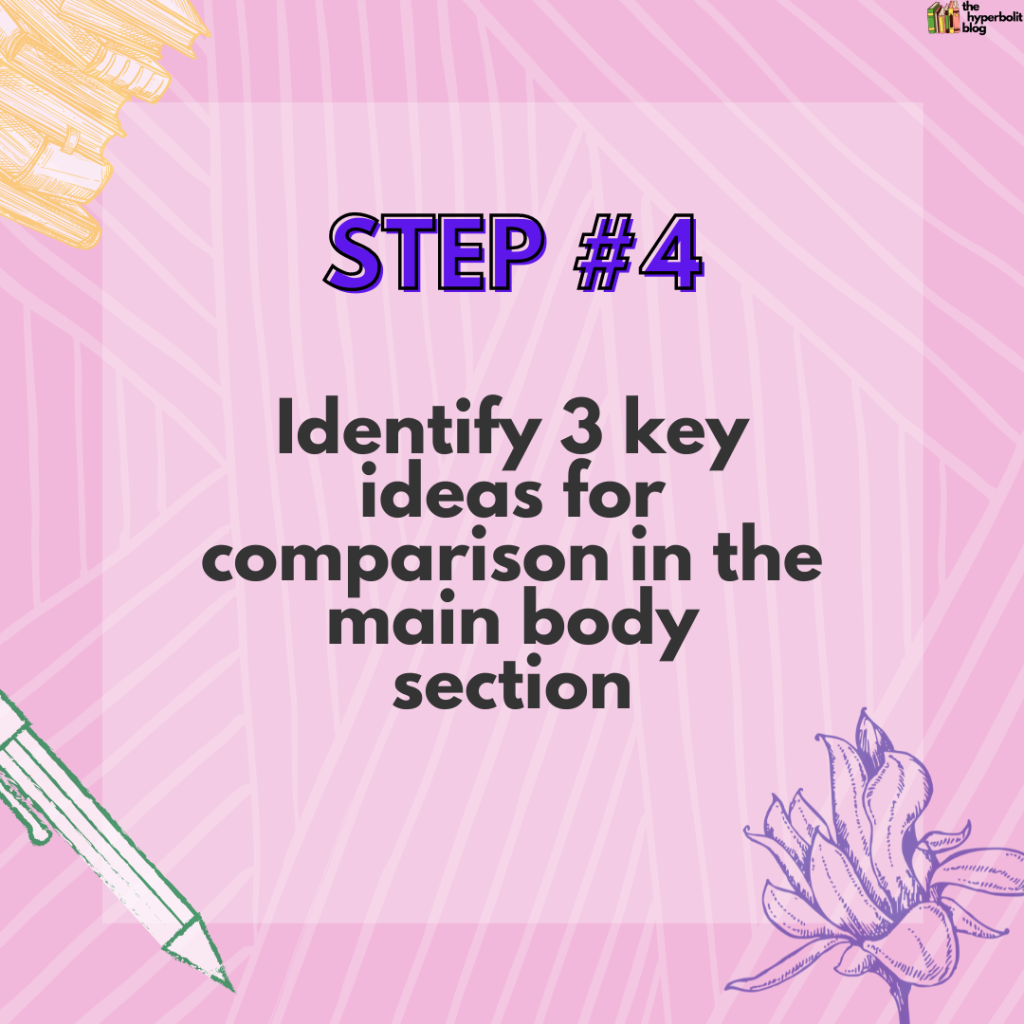
Finally, let’s summarise the poems’ similarities and differences in a comparative statement.
This should be the guiding thesis for your essay, which also doubles as your main line of argument and cascades into points of analysis for the main body section.
Perhaps it seems a bit odd to ‘work backwards’ by coming up with the introductory thesis at the end of our planning process, but it works, because when you think about it, your argument should be a distillation of your main points, which are the specifics in each main body paragraph.
To formulate the thesis, use comparative sentence structures like the following:
While both Poem A and Poem B are about…, Poem A portrays… as…, whereas Poem B casts… as…
Poem A and Poem B are concerned with…, but Poem A presents… in a … light, while Poem B paints… as…
In Poem A, … is depicted as… However, this same subject matter is dealt with differently in Poem B, where the poet portrays… as…
Your comparative thesis should be thematic in nature (i.e. it spells out how a theme is portrayed across both poems); any shared or different techniques could either be left to the main body analysis, or – if it helps clarify your focus as you go on to write the rest of your essay – you could add one follow-up sentence after the comparative thesis to summarise the technical overlaps and divergences between the poems.
For example, “Poem A relies mainly on comparative devices and imagery, while Poem B features personification and rhyme to convey the nuances of…” etc etc. But this is largely optional.
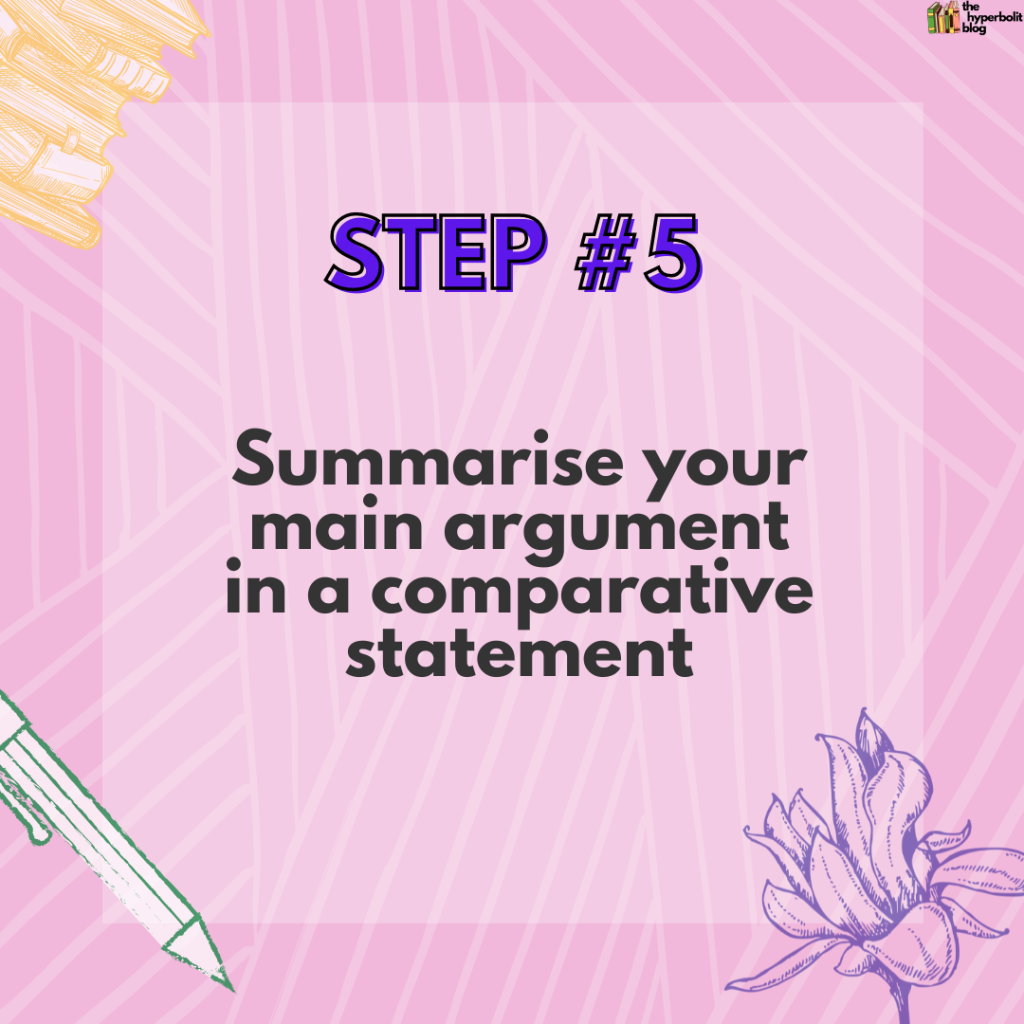
Quick demonstration: Carol Rumens’ ‘The Emigree’ vs Seamus Heaney’s ‘Storm on an Island’ | AQA GCSE English Literature Power and Conflict Poetry
Below, I’ll demonstrate how we can apply these steps to a comparison between two GCSE Power and Conflict poems – Carol Rumens’ ‘The Emigree’ and Seamus Heaney’s ‘Storm on an Island’.
You can refer to the texts here (The Emigree) and here (Storm on an Island).
In ‘Emigree’, the persona is a political exile (hence the title) who has left her home country to escape political persecution. In the poem, she reminisces about her native city with nostalgic fondness, while conveying her awareness of the tyrannical threat that lurks in the shadows of her past. In a nutshell, she misses home but knows that she will probably never be able to return.
The main idea of ‘Storm in an Island’ is that we’re often afraid of things that aren’t out to get us. We prepare for potential dangers, and yet are unaware that we can’t always prepare for them, or that they usually turn out to not be dangerous at all. In this poem, the persona initially sees nature as a force of threat, but ultimately understands that while nature is forceful, it doesn’t have to be threatening.

Main idea 1: Preserving the home against external dangers
- In ‘The Emigree’, the persona fights back against her political persecutors by preserving a pure memory of her home city
- In ‘Storm’, the persona braces himself for a potentially devastating storm by fortifying the structures of his home
- Techniques used: war and natural imagery
Main idea 2: Reality vs expectation / ideal
- In ‘The Emigree’, the persona would ideally like to return to her city, but it is implied that those in power back home do not welcome her presence.
- In ‘Storm’, the persona anticipates a threatening storm, but ultimately realises that it’s much less destructive than he had expected it to be.
- Techniques used: alliteration (plosives vs sibilants)
Main idea 3: The turbulent nature of life
- In ‘The Emigree’, the persona is unmoored from her roots, and as an exile, she constantly struggles with conflicted emotions about wanting to return and yet knowing that she probably can never do so.
- In ‘Storm’, nature is seen to be a turbulent force that changes in ways humans can’t quite anticipate.
- Techniques used: enjambment and varied lineation
Both ‘The Emigree’ and ‘Storm on an Island’ present the individual in the face of external dangers, whether real or imagined. However, while Rumens’ persona faces the threat of political persecution, and chooses to counter it by preserving a purer memory of her home, Heaney’s persona over-calculates the dangers of the storm, and eventually discovers that his fear of nature is largely unjustified.
Bit of a mammoth post, I know, but I hope this helps break down the poetry comparison process into digestible chunks! If you have any questions, reach out to me here .
To read other study guides, check out my posts below:
- How to ace any Shakespeare question
- How to analyse any unseen poem – 3 top tips
- How to revise for English Literature – 8 top tips
share this with a friend!
- Click to share on WhatsApp (Opens in new window)
- Click to share on Facebook (Opens in new window)
- Click to share on Twitter (Opens in new window)
- Click to email a link to a friend (Opens in new window)
Leave a comment Cancel reply

- Already have a WordPress.com account? Log in now.
- Subscribe Subscribed
- Copy shortlink
- Report this content
- View post in Reader
- Manage subscriptions
- Collapse this bar
Comparing Poems
After studying this section you should be able to understand:
- what features to look for in each poem
- how to plan and write your response
As part of the GCSE English Literature course, one of the things you will need to do is to ‘explore relationships and comparisons between text, selecting and evaluating relevant material ’. One of the ways in which you might be asked to do this is to compare two poems.
When comparing poems you need to look for all the features that you look for when studying a single poem.
You need to look at the:
- content of the poem
- tone and mood of the poem
- form in which it is written and structured
- ways in which language is used
When writing your response, avoid writing an examination of one poem and then the other and comparing them in a final paragraph. Integrate your comments on the poems throughout.
However, you also need to compare these features in both poems.
You will need to look at each poem individually to plan your response, but when writing your response you need to integrate your ideas on both poems.
Watch the video below to help you understand key poetic terms and the forms and structure of poetry to help you analyse and compare poems for your unseen poetry paper.
Here’s one way you could approach this task:
Planning your response
1. Read both poems through carefully and get an overall sense of what each poem is about and how the poets handle their topics.
2. Re-read poem ‘A’ and make brief notes either around the poem, if you are able, or on a separate sheet, noting key words, phrases, images etc. and your response to it. Do the same with poem ‘B’.
3. Note down some brief quotations from each poem that you will use to illustrate your ideas. You could underline or circle these if you can write on the copy of the poem.
4. Make two lists – one headed similarities and one headed differences and list the main points under each heading.
Writing the response
It is important that you avoid writing an essay on each poem and then try to join them together. The best responses are those that integrate the ideas in parallel throughout the essay.
Here’s one way you could approach this:
INTRODUCTION
Introductory paragraph commenting on what each poem is about and capturing the ‘flavour’ of each.
Several paragraphs based on your detailed reading of the poems. It is a good idea to make a point about poem ‘A’ and then a point about poem ‘B’.
It can help you structure your ideas in a logical way, e.g. one paragraph could compare the way each uses imagery , while another paragraph could focus on structure etc.
A concluding paragraph, summing up the main similarities and differences, saying which you find more effective and why, if you are asked this .
Keep both poems at the centre of your focus and don’t be tempted to write all about one and then the other.


Anthony Cockerill
| Writing | The written word | Teaching English |
Teach your students how to compare poems for GCSE English Literature, Paper 2, Section B
Learn some of these brilliant strategies for teaching really effective poetry comparison for GCSE English Literature, Paper 2, Section B.
One of the elements of our students’ exam performance we identified as a weakness in last summer’s examination series was comparing poems from the AQA poetry anthology, Poems Past and Present, which forms part of GCSE English Literature Paper Two. In the English Department at Boroughbridge High School, where we teach the Power and Conflict cluster, we’ve been spending time over these past few weeks taking a closer look at what our students need to do in order to write a great poetry comparison. Using our current students’ work alongside papers we recalled from last summer – plus the ever helpful examiner’s report – we’re working to establish some maxims for how we teach this particular aspect of the examination, which I’d like to share with you in this blog post.
1. Get your students to know the poems really well.
‘Students who knew the text were able to move around and within it in order to respond to the specifics of the task.’ AQA Examiners’ report, June 2017.
There are some great ways to introduce students to poems, such as D irected A ctivities R elated to T exts, in which a student is usually instructed to reconstruct or resequence a text. An activity might encourage students to think about the form of the text, the structure, or the recurrence of particular types of language.

As a first encounter with Seamus Heaney’s ‘Storm on the Island’, students might consider what the poem could be about by exploring the nouns. Are there any patterns? Could they be classified into lexical fields? Or they might attempt to write a poem or description using words sorted by their function. Alternatively, a teacher might encourage students to engage intellectually or emotionally with the poem by exploring a still image, a moving image clip or by sharing a story.
The subsequent process of the shared reading of the poem in its entirety and the ensuing discussion is a great opportunity to model the process of reading, understanding and thinking analytically. A series of prompts – or something akin to ‘Key Questions’ – can work as a framework for class discussion, enabling students to think, and ultimately write, about the poems and also to provide a ‘schema’ to help them build and consolidate their knowledge and understanding.

When helping students to deal with aspects of language and structure, a teacher might provide a tool to help students structure their thinking and note-making (the acronym FLIRTS, for example, which stands for F orm and Structure, L anguage and Sounds, I magery, R hyme, Rhythm and Repetition, T heme and Tone, S peaker).
2. Cluster and study the poems thematically to help students to make a good choice of second poem.
‘The selection of the second poem is one of the keys to success as this gives the student the material to construct a holistic response.’ AQA Examiners’ report, June 2017.
The Power and Conflict cluster could be usefully divided into poems about power and legacy; poems about the power of natural world and conflict with humans; poems about conflict that can happen as a result of culture and belonging; poems about war and conflict. Thinking about the poems in these clusters will guide students toward making a helpful choice of second poem.
3. Don’t constrict written responses with a rigid framework, but instead provide more flexible ways of comparing the poems.
‘One examiner commented that one of their key teaching points for next year will be that “comparison comes in a variety of shapes and does not have to be formulaic”‘. AQA Examiners’ report, June 2017.
Some of the possible ways of structuring a poetry comparison can lead to answers which can constrain the level of the response. This can usually be evident when ‘essay plans’ are too simplistic (Poem A, then Poem B) or too artificial (Similarities and Differences) but also when they become too unwieldy. But the examiners’ report suggests that ‘…the key message here is to enable and guide students to form a comparison relative to their level of ability.’ In engaging with the poems, a student aiming for a top grade should aim for a conceptualised response which is exploratory in nature. A confident student might write an ambitious introduction which outlines their ‘angle’ on the question. They might seek an interesting angle on the task, such as how patriotism might lead soldiers into combat. Then they might develop their response along a series of conceptual lines of enquiry, integrating analysis of the writers’ methods as they go; illuminating their interpretation with contextual insight relevant to the task.

Rather than offering up a rigid ‘essay plan’, the ‘series of prompts’ I described above as a cognitive tool can function, when applied to both poems, as a sort of ‘loose structure’ to help students produce a more focused written response. I have found these ‘Key Questions’ to be useful in encouraging students to focus on a comparison of two poems. ‘What are the poems about?’ serves as an introduction to the whole response.

‘Who is ‘speaking’ in the poems?’, as I discuss in more detail below, allows the student to engage with the ‘constructed voice’ of the poem. ‘How has the poet used language and structure to convey their message?’ allows students to consider the writers’ methods. ‘Why have the poems been written?’ offers the opportunity to explore deeper layers of meaning, authorial intent and conceptual interpretations. However, it’s important to think of this approach as flexibly as possible. It wouldn’t be good, for example, to encourage students to think of the Key Question ‘why have the poems been written?’ as an opportunity to shoehorn context into their response. Ideas, exploration of the writers’ methods and apt integration of context should be evident throughout the response.
4. Think about the voice as a construct.
‘Students who recognised where the voice was a construct were more successful than those who regurgitated biographical information about the poet that they then attempted to link to the poetic voice.’ AQA Examiners’ report, June 2017.
Addressing the task itself – and considering why the poems might have been written – will enable the student to naturally explore context – rather than including lots of biographical information. But the ‘persona’ of the constructed voice might also provide a very useful way of considering context. In Simon Armitage’s ‘Remains’, for example, the narrative voice deftly reflects the turmoil of someone struggling to come to terms with what they’ve seen. Armitage’s narrator uses first-person plural pronouns, for example, to emphasise the narrator’s attempt to redistribute his own guilt among his comrades. Similarly in ‘Beatrice Garland’s ‘Kamikaze’, the modulating narrative perspective creates distance between the reader and the narrator that reflect the gulf between pilot and family. Context in this analysis, therefore, becomes implicitly connected to the student’s understanding of the task.
5. Make sure students understand the importance of answering the question.
When students start to write their responses – and if they’re using my ‘Key Questions’ approach, they’ll begin by considering what the poems are about – they must respond in terms of the question rather than with something generic. ‘Ozymandias’ by Percy Bysshe Shelley for example, explores the power of the natural world, but if the question is about the theme of mortality, then it is through this filter that the student must construct their response. It’s useful reiterate the key word from the question throughout throughout the answer to keep the response on track.
6. Get students to engage with the poem, rather than obsessing about poetry terminology.
‘Some responses set out to identify poetic techniques and employ as much terminology as possible before engaging with the poems themselves.’ AQA Examiners’ report, June 2017.
Sometimes, a student who is too heavy handed with various poetry terms can find themselves attributing questionable effects to the features they’ve ‘spotted’. It’s much better to encourage students to consider different layers of meaning in language and to consider possible interpretations.

7. Flexible analytical writing is much more effective than the PEE paragraph.
‘The use of structures such as PEE / PEA and its variants worked in the sense that they allowed students working at the lower levels to access Level 3 in the mark scheme. However less rigid structures worked better for those working at higher levels.’ AQA Examiners’ report, June 2017.
As I have explained in an earlier blog post , I’m not sure I always taught analytical writing well earlier in my teaching career. For me, like many, the PEE paragraph was a formula to get students through coursework essays and to use as a model for exam-style responses.
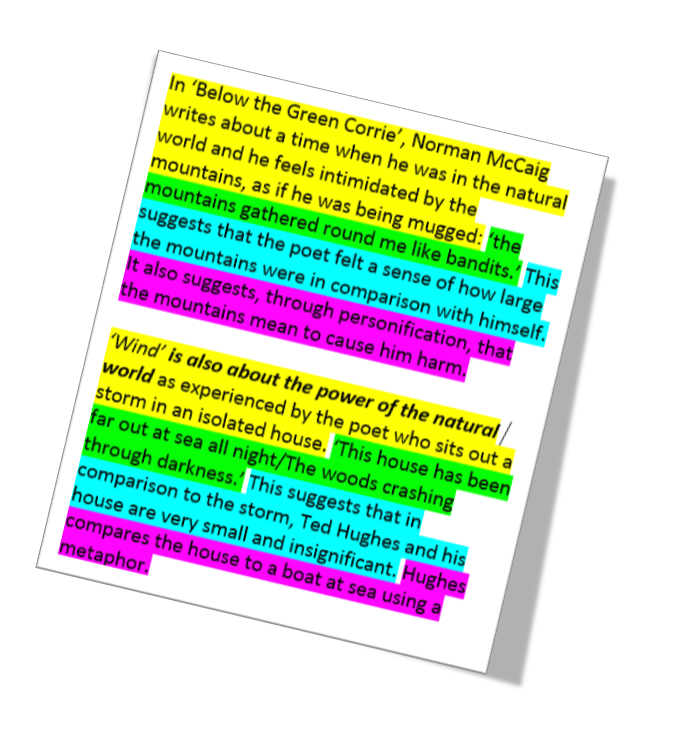
8. Teach students to integrate and embed short quotations – it’s much more effective than copying out longer quotations.

It’s much more productive when students embed judiciously chosen, short quotations into the essay, rather than wasting time copying out large chunks of text. The response will feel much more fluid.
9. Encourage students to write individual responses with precise, cogent expression and more sophisticated analytical writing techniques.
When aiming for top flight responses, there are several techniques students can deploy as part of a well-structured, insightful essay. These include evaluation, anticipating the response of the reader, tentativity, spotting patterns and deepening analysis are some great ways of making analytical writing more ambitious.

Here, the student has spotted patterns of language throughout the poem.
The student here has noted the ambiguity of the poem in this example of deepening analysis…
10. Familiarise students with how their work will be marked.
‘Mark schemes’ should be used with care, as the process of arriving at a level is a subjective judgement based around a guided standardisation process. Futhermore, the meta-language around each level needs to be properly exemplified and understood – something even experienced teachers and examiners need ongoing support with. This said, it is always a worthwhile exercise to share with students an exemplar script or two and a ‘friendly’ version of the mark scheme they can use to become familiar with the standard and where their own writing sits.
Photo by Artur Matosyan on Unsplash
- Click to share on Twitter (Opens in new window)
- Click to share on Facebook (Opens in new window)
- Click to share on Pinterest (Opens in new window)
- Click to email a link to a friend (Opens in new window)
Published by Anthony Cockerill
'Stay[ing] gold.’ View all posts by Anthony Cockerill

- Already have a WordPress.com account? Log in now.
- Subscribe Subscribed
- Copy shortlink
- Report this content
- View post in Reader
- Manage subscriptions
- Collapse this bar
Have a language expert improve your writing
Run a free plagiarism check in 10 minutes, generate accurate citations for free.
- Knowledge Base
- Comparing and contrasting in an essay | Tips & examples
Comparing and Contrasting in an Essay | Tips & Examples
Published on August 6, 2020 by Jack Caulfield . Revised on July 23, 2023.
Comparing and contrasting is an important skill in academic writing . It involves taking two or more subjects and analyzing the differences and similarities between them.
Instantly correct all language mistakes in your text
Upload your document to correct all your mistakes in minutes

Table of contents
When should i compare and contrast, making effective comparisons, comparing and contrasting as a brainstorming tool, structuring your comparisons, other interesting articles, frequently asked questions about comparing and contrasting.
Many assignments will invite you to make comparisons quite explicitly, as in these prompts.
- Compare the treatment of the theme of beauty in the poetry of William Wordsworth and John Keats.
- Compare and contrast in-class and distance learning. What are the advantages and disadvantages of each approach?
Some other prompts may not directly ask you to compare and contrast, but present you with a topic where comparing and contrasting could be a good approach.
One way to approach this essay might be to contrast the situation before the Great Depression with the situation during it, to highlight how large a difference it made.
Comparing and contrasting is also used in all kinds of academic contexts where it’s not explicitly prompted. For example, a literature review involves comparing and contrasting different studies on your topic, and an argumentative essay may involve weighing up the pros and cons of different arguments.
Here's why students love Scribbr's proofreading services
Discover proofreading & editing
As the name suggests, comparing and contrasting is about identifying both similarities and differences. You might focus on contrasting quite different subjects or comparing subjects with a lot in common—but there must be some grounds for comparison in the first place.
For example, you might contrast French society before and after the French Revolution; you’d likely find many differences, but there would be a valid basis for comparison. However, if you contrasted pre-revolutionary France with Han-dynasty China, your reader might wonder why you chose to compare these two societies.
This is why it’s important to clarify the point of your comparisons by writing a focused thesis statement . Every element of an essay should serve your central argument in some way. Consider what you’re trying to accomplish with any comparisons you make, and be sure to make this clear to the reader.
Comparing and contrasting can be a useful tool to help organize your thoughts before you begin writing any type of academic text. You might use it to compare different theories and approaches you’ve encountered in your preliminary research, for example.
Let’s say your research involves the competing psychological approaches of behaviorism and cognitive psychology. You might make a table to summarize the key differences between them.
Or say you’re writing about the major global conflicts of the twentieth century. You might visualize the key similarities and differences in a Venn diagram.

These visualizations wouldn’t make it into your actual writing, so they don’t have to be very formal in terms of phrasing or presentation. The point of comparing and contrasting at this stage is to help you organize and shape your ideas to aid you in structuring your arguments.
When comparing and contrasting in an essay, there are two main ways to structure your comparisons: the alternating method and the block method.
The alternating method
In the alternating method, you structure your text according to what aspect you’re comparing. You cover both your subjects side by side in terms of a specific point of comparison. Your text is structured like this:
Mouse over the example paragraph below to see how this approach works.
One challenge teachers face is identifying and assisting students who are struggling without disrupting the rest of the class. In a traditional classroom environment, the teacher can easily identify when a student is struggling based on their demeanor in class or simply by regularly checking on students during exercises. They can then offer assistance quietly during the exercise or discuss it further after class. Meanwhile, in a Zoom-based class, the lack of physical presence makes it more difficult to pay attention to individual students’ responses and notice frustrations, and there is less flexibility to speak with students privately to offer assistance. In this case, therefore, the traditional classroom environment holds the advantage, although it appears likely that aiding students in a virtual classroom environment will become easier as the technology, and teachers’ familiarity with it, improves.
The block method
In the block method, you cover each of the overall subjects you’re comparing in a block. You say everything you have to say about your first subject, then discuss your second subject, making comparisons and contrasts back to the things you’ve already said about the first. Your text is structured like this:
- Point of comparison A
- Point of comparison B
The most commonly cited advantage of distance learning is the flexibility and accessibility it offers. Rather than being required to travel to a specific location every week (and to live near enough to feasibly do so), students can participate from anywhere with an internet connection. This allows not only for a wider geographical spread of students but for the possibility of studying while travelling. However, distance learning presents its own accessibility challenges; not all students have a stable internet connection and a computer or other device with which to participate in online classes, and less technologically literate students and teachers may struggle with the technical aspects of class participation. Furthermore, discomfort and distractions can hinder an individual student’s ability to engage with the class from home, creating divergent learning experiences for different students. Distance learning, then, seems to improve accessibility in some ways while representing a step backwards in others.
Note that these two methods can be combined; these two example paragraphs could both be part of the same essay, but it’s wise to use an essay outline to plan out which approach you’re taking in each paragraph.
Prevent plagiarism. Run a free check.
If you want to know more about AI tools , college essays , or fallacies make sure to check out some of our other articles with explanations and examples or go directly to our tools!
- Ad hominem fallacy
- Post hoc fallacy
- Appeal to authority fallacy
- False cause fallacy
- Sunk cost fallacy
College essays
- Choosing Essay Topic
- Write a College Essay
- Write a Diversity Essay
- College Essay Format & Structure
- Comparing and Contrasting in an Essay
(AI) Tools
- Grammar Checker
- Paraphrasing Tool
- Text Summarizer
- AI Detector
- Plagiarism Checker
- Citation Generator
Some essay prompts include the keywords “compare” and/or “contrast.” In these cases, an essay structured around comparing and contrasting is the appropriate response.
Comparing and contrasting is also a useful approach in all kinds of academic writing : You might compare different studies in a literature review , weigh up different arguments in an argumentative essay , or consider different theoretical approaches in a theoretical framework .
Your subjects might be very different or quite similar, but it’s important that there be meaningful grounds for comparison . You can probably describe many differences between a cat and a bicycle, but there isn’t really any connection between them to justify the comparison.
You’ll have to write a thesis statement explaining the central point you want to make in your essay , so be sure to know in advance what connects your subjects and makes them worth comparing.
Comparisons in essays are generally structured in one of two ways:
- The alternating method, where you compare your subjects side by side according to one specific aspect at a time.
- The block method, where you cover each subject separately in its entirety.
It’s also possible to combine both methods, for example by writing a full paragraph on each of your topics and then a final paragraph contrasting the two according to a specific metric.
Cite this Scribbr article
If you want to cite this source, you can copy and paste the citation or click the “Cite this Scribbr article” button to automatically add the citation to our free Citation Generator.
Caulfield, J. (2023, July 23). Comparing and Contrasting in an Essay | Tips & Examples. Scribbr. Retrieved April 2, 2024, from https://www.scribbr.com/academic-essay/compare-and-contrast/
Is this article helpful?

Jack Caulfield
Other students also liked, how to write an expository essay, how to write an argumentative essay | examples & tips, academic paragraph structure | step-by-step guide & examples, "i thought ai proofreading was useless but..".
I've been using Scribbr for years now and I know it's a service that won't disappoint. It does a good job spotting mistakes”
- International
- Schools directory
- Resources Jobs Schools directory News Search
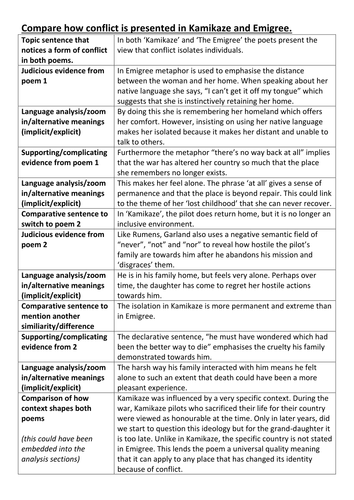
How to structure a comparative paragraph for AQA Poetry - Power and Conflict
Subject: English
Age range: 14-16
Resource type: Worksheet/Activity
Last updated
4 August 2023
- Share through email
- Share through twitter
- Share through linkedin
- Share through facebook
- Share through pinterest

10+ Resources to teach students methods for comparing poems from the AQA anthology. Includes ideas for discriminating comparisons by both theme and method. The model examples come from the Power and Conflict AQA anthology and include plans for…
The Emigree and Kamikaze Exposure and War Photographer. Exposure and Storm on the Island Tissue and Ozymandias Remains and Bayonet Charge Prelude and Ozymandias London and My Last Duchess
There is also a blank template for students to practise using the 12 point comparative method on a question comparing Ozymandias and My Last Duchess.
There is also a choice over a simple 4 paragraph methods based approach or a more advanced 2 paragraph conceptual approach.
There is also a diamond ranking starter activity to get students to engage with the criteria for grade 8 and 9.
There is also a resource with 3 tiers of difficulty depending on how confident students are at planning their own comparisons.
Tier 1: Students add the analysis of the quotations. The topic sentences and recommended quotations are already filled in for them. Tier 2: Students must pick their own 3 quotations from each poem and analyse the quotations. Tier 3: Students must pick their own topic sentences, quotations and then analsyse the quotations.
The questions covered are as follows:
2021 question: Compare how poets present ideas about power and control in ‘London’ and in one other poem from ‘Power and conflict’. (30)
Nov 2020 question: Compare how poets present the ways people are affected by difficult experiences in ‘Remains’ and in one other poem from ‘Power and conflict’. (30)
May 2019 question: Compare how poets present the ways that people are affected by war in ‘War Photographer’ and in one other poem from ‘Power and conflict’. (30)
May 2018 question: Compare how poets present ideas about power in ‘Ozymandias’ and in one other poem from ‘Power and conflict’. (30)
Tes paid licence How can I reuse this?
Get this resource as part of a bundle and save up to 89%
A bundle is a package of resources grouped together to teach a particular topic, or a series of lessons, in one place.
Power and Conflict Revision Bundle
Bundle contains the following: * Annotations for all 15 poems * Revision cards * Knowledge organiser (2 versions) * Quizzes * Thesis statements * Comments on structure * Key quotation annotations * Writing frames * model essay * model introductions I do have other power and conflict resources available: Bundle https://www.tes.com/teaching-resource/power-and-conflict-revision-11626301 Model answers: https://www.tes.com/teaching-resource/power-and-conflict-grade-9-model-essays-12213236 Revision cards: https://www.tes.com/teaching-resource/power-and-conflict-revision-cards-12107049
Power and Conflict Revision 2023
Revision tasks for AQA Power and Conflict.<br /> <br /> Lots of revision activities for the Power and Conflict poems including:<br /> <br /> 10 writing frames<br /> Revision grids<br /> Revision card templates<br /> Graphic Organisers<br /> Model essays<br /> Writing comparative sentences<br /> Revision Quiz
Comparing Power and Conflict Poems
A range of resources about how to compare Power and Conflict poems which include: - 10 writing frames - Model paragraphs - 40 pairs of quotations that are useful for comparing - using a revision grid to plan comparisons and lots of other ideas
Your rating is required to reflect your happiness.
It's good to leave some feedback.
Something went wrong, please try again later.
Empty reply does not make any sense for the end user
Salopteacher
12 Point comparison grid very useful in simplifying how to write a comparative paragraph; currently have bright kids that show good understanding - but struggle to analyse effectively - this should be a big help.
Report this resource to let us know if it violates our terms and conditions. Our customer service team will review your report and will be in touch.
Not quite what you were looking for? Search by keyword to find the right resource:
Resources you can trust
Comparing poems writing frame
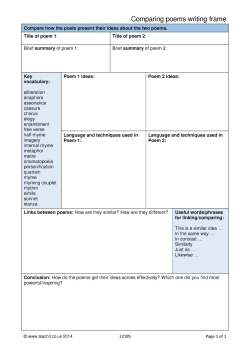
A blank template for students to complete to compare the features of two poems. Prompts encourage students to summarise the:
- poems' topic
- poems' ideas
- language and techniques
- links and contrasts between the poems.
Key vocabulary banks are included to remind students of the key poetic terminology and linking words and phrases.
All reviews
Have you used this resource?
Sonia Jallane
Tasnim Azad
Resources you might like

IMAGES
VIDEO
COMMENTS
Comparing two poems typically involves analyzing the content and structure of the poetry, as well as its universal themes, language, and the imagery used. Writing a poetry comparison essay is considered a formidable task for many because determining the similarities and differences between two pieces of poetry can be quite difficult.
However in structure B, the comparison takes place throughout the whole essay and avoids looking at the poems separately. This is a better model to use and one which can be applied to comparisons ...
Two Useful Mnemonics for a Poetry Essay: S.M.I.L.E. and F.I.E.L.D. A mnemonic is a familiar group of letters to help you memorise something through association with those letters. For example, to help you compare the poems and to write the essay, these two acronyms may come in handy: SMILE: Structure, Meaning, Imagery, Language, Effect
Structuring Your Essay: Introduction: Introduce the poems and poets, providing context if necessary. Present your thesis statement, outlining the main points of comparison. Body Paragraphs: Topic Sentences: Start each paragraph with a clear topic sentence that states the aspect of comparison. Comparison: Analyse each poem separately, focusing ...
Method 2: Switch between paragraphs. The other way for how to compare and contrast poems is to switch between works every paragraph. In this way, you discuss one element of one poem and move on to discuss the same element in the second poem. Often, this method is the easiest for a reader to follow.
Poetry comparison - or writing a comparative essay about two poems, seen or unseen - is what students will eventually be assessed on when they come to sit the poetry analysis part of their English Literature GCSE. It makes sense, therefore, to get some early poetry comparison practice in. See what the assessment criteria will be asking for ...
Step 5: Summarise your main argument in a comparative statement. Finally, let's summarise the poems' similarities and differences in a comparative statement. This should be the guiding thesis for your essay, which also doubles as your main line of argument and cascades into points of analysis for the main body section.
Overview Structuring a comparative essay Comparing themes, ideas and attitudes Compare the effect of form, structure and language Comparing contexts Thinking about two poems and identifying where ...
Overview. You can discover a lot about a poem by comparing it to one by another poet that deals with a similar subject or has a similar. theme. . Thinking about two poems and identifying where ...
It is not necessarily the best structure to use, and you should follow the advice of your teacher first and foremost, but this is one way that you could structure this essay: A comparative thesis as an introduction - this only need be two or three sentences long. 3 analysis paragraphs. a. Poem 1 - core difference/similarity from thesis. b.
Structuring the Essay. Your exam question paper will ask you to compare two of your studied anthology poems. This can seem daunting, especially as you have to write about two separate poems in one essay, and that only one of these poems is printed in the exam paper. However, examiners just want to see your ideas and opinions on the poems you ...
Main Paragraphs. Now, we come to the main body of the essay, the quality of which will ultimately determine the strength of our essay. This section should comprise of 4-5 paragraphs, and each of these should analyze an aspect of the poem and then link the effect that aspect creates to the poem's themes or message.
Watch the video below to help you understand key poetic terms and the forms and structure of poetry to help you analyse and compare poems for your unseen poetry paper. Here's one way you could approach this task: Planning your response. 1. Read both poems through carefully and get an overall sense of what each poem is about and how the poets ...
One of the elements of our students' exam performance we identified as a weakness in last summer's examination series was comparing poems from the AQA poetry anthology, Poems Past and Present, which forms part of GCSE English Literature Paper Two. In the English Department at Boroughbridge High School, where we teach the Power and Conflict cluster, we've been spending time over these ...
When comparing and contrasting in an essay, there are two main ways to structure your comparisons: the alternating method and the block method. The alternating method. In the alternating method, you structure your text according to what aspect you're comparing. You cover both your subjects side by side in terms of a specific point of comparison.
Let's take a look at a higher-level paragraph in a comparative poetry essay: Compare how the poets explore ideas related to grief and sorrow in "Poem at Thirty-Nine" and "Remember." ... As long as IGCSE English students master a comparative essay structure and receive adequate guidance for poetry analysis, they will be able to do well ...
Below you will find a full-mark, Level 6 model answer for a poetry anthology comparison essay. The commentary below each section of the essay illustrates how and why it would be awarded Level 6. Despite the fact it is an answer to a specific Power and Conflict question, the commentary below is relevant to any poetry anthology question.
These tips show you how to analyse exam questions, structure essays and write in an appropriate style. ... If comparing poems, make it clear which ones you are writing about. Essay section:
10+ Resources to teach students methods for comparing poems from the AQA anthology. Includes ideas for discriminating comparisons by both theme and method. The model examples come from the Power and Conflict AQA anthology and include plans for…. The Emigree and Kamikaze. Exposure and War Photographer.
A blank template for students to complete to compare the features of two poems. Prompts encourage students to summarise the: poems' topic. poems' ideas. language and techniques. links and contrasts between the poems. Key vocabulary banks are included to remind students of the key poetic terminology and linking words and phrases.